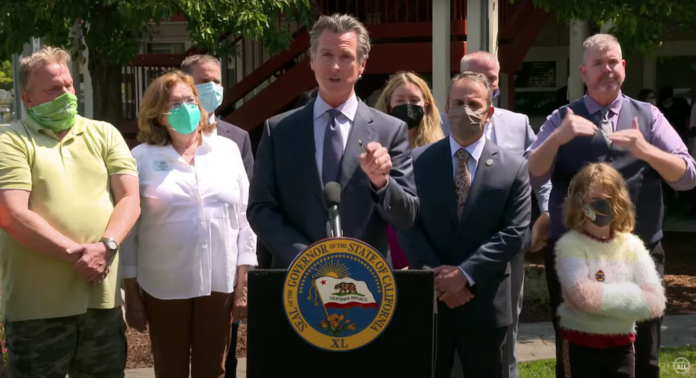Gov. Gavin Newsom headed to Sebastopol on July 19 to sign a $12 billion trailer bill addressing homelessness, as part of his California Comeback Plan.
He held up the paper right in front of the former Sebastopol Inn, now named Elderberry Commons, an example of how the county used funds from the state’s Project Homekey program. At the end of 2020, the county purchased the former hotel site and remodeled its 31 rooms to house homeless individuals vulnerable to COVID-19, as part of the state’s Project Homekey. In mid-2020, the county began the process of looking into purchasing the site. It received $6.375 million from Project Homekey to purchase the property in November, and had residents moving in by the end of the year.
“Thank you very much for being here. We’re a wonderful little town and we have a wonderful facility here that our community is very proud of,” said Sebastopol Mayor Una Glass.
The governor spoke on statewide efforts to address homeless and the historic significance of what he called the state’s biggest homelessness package yet.
“The state of California, with all due respect, has been nowhere to be found on the issue of homelessness for far too long,” Newsom said.
Crediting former governor Jerry Brown’s administration for turning toward partnerships, solutions and addressing root causes of homelessness, Newsom said his own administration went on to set a state record investing $950 million in Continuum of Care programs, which are local and regional systems that support services and housing for homeless individuals.
The $12 billion trailer bill breaks that record, he said.
“Today, we’re taking it to a whole different level. When we talk about investments and we put it in terms of historical investments, we need to go back to 1967 when this state began the systemic dismantling of behavioral health housing here in the state of California,” he said, citing Ronald Reagan’s gubernatorial budget that tore down supports that impacted people struggling with bipolar, schizophrenia, paranoia and addiction as self-medication.
The state seeks to demonstrate accountability for supporting people living in homelessness after decades of the state and the nation withdrawing its support systems since Reagan struck the blow, Newsom said.
Commitments from the bill include $3 billion toward “board and care, for conservatorships, for Laura’s Law placements, to provide opportunities for people in crisis,” according to the governor.
Another $2 billion across the next two years is coming for “discretionary support” to go to efforts like providing rental subsidies, motel conversions and rapid housing, he said.
Newsom recounted a call from Fourth District Supervisor James Gore, who was present, urging him to call on the county to answer for their received funding with results. From there, the package came to include accountability requirements and metrics for counties to uphold.
“No plan, no money,” he said, explaining that counties that can show for their plans and meet the required metrics could receive an 18% bonus.
He thanked the supervisors for securing the Elderberry Commons site to get people into housing in around five months.
The Project Homekey program aids more than 10,000 people at the moment, while Project Roomkey obtained temporary housing for 42,000 people during the pandemic, “off the streets and sidewalks and out of shelters” according to Newsom.
“We have fewer than 8,000 residents in the city of Sebastopol and so if a small city can step up and be part of the solution, any city in the state of California can be part of that solution,” said Lynda Hopkins, chair of the board of supervisors and leader of the Fifrth District before Newsom was introduced.
With Glass standing behind him at his shoulder, the governor took pen to paper at the podium and held it up for the people to see.
“This is a new day in terms of our strategies,” he said. “You need three things to actually make an impact on homelessness. You need to have a plan. The state didn’t have one for decades. You need to have the resources. Even if they had a plan, they didn’t have the money. And three, you’ve got to have political will.”








